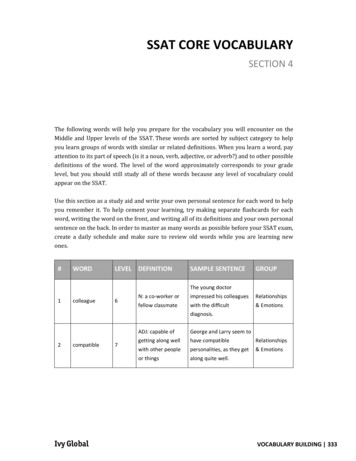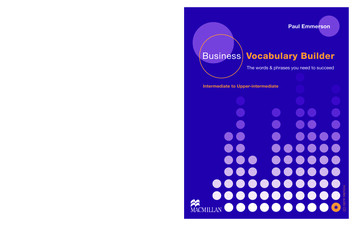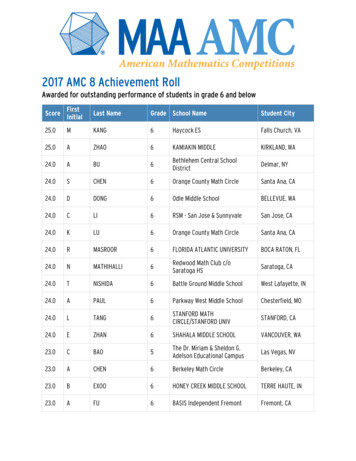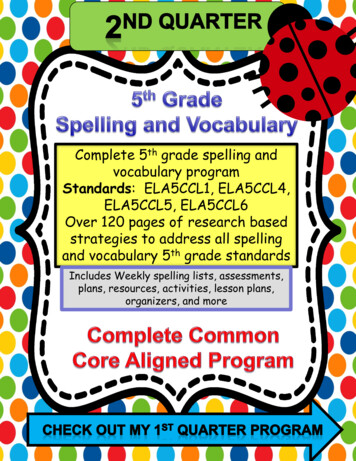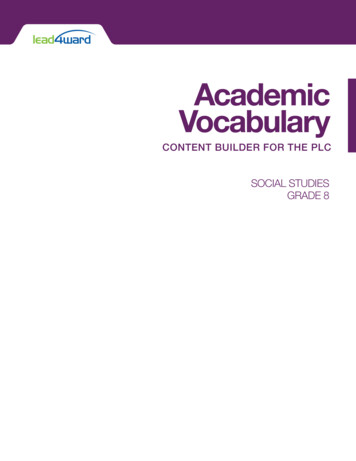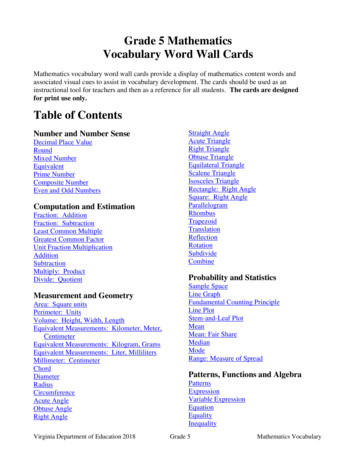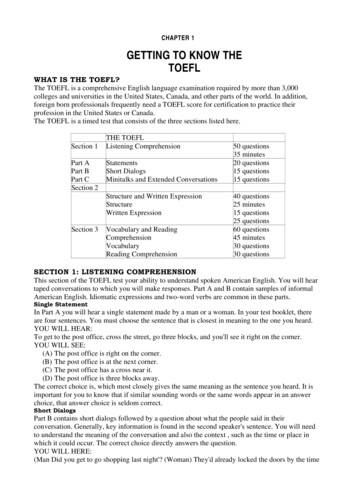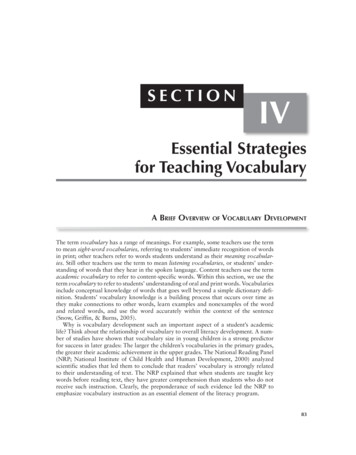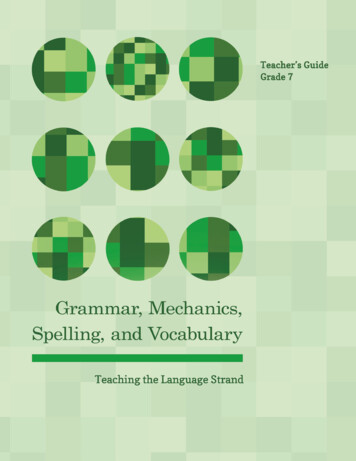
Transcription
Vocabulary WorksheetsVocabulary StandardsThe Common Core State Standards (CCSS) in English Language Arts divides vocabularydevelopment among a variety of instructional strands across the grade-levels. For example, theReading Strand in both Literature and Informational Text includes the same Standard (8.4):“Determine the meaning of words and phrases as they are used in a text, including figurative andconnotative meanings; analyze the impact of specific word choices on meaning and tone,including analogies or allusions to other texts.”However, most of the specific Vocabulary Standards are placed in the K-12 Language Strand.The CCSS L.4, 5, 6 Vocabulary Standards specify the following components of vocabularyinstruction: Multiple Meaning Words and Context Clues (L.4.a.)Greek and Latin Word Parts (L.4.a.)Language Resources (L.4.c.d.)Figures of Speech (L.5.a.)Word Relationships (L.5.b.)Connotations (L.5.c.)Academic Language Words (L.6.0)Vocabulary InstructionThe bulk of Tier I Words (conversational words) and some Tier II words (generalizableacademic words) are acquired primarily through independent reading. However, many Tier IIand III Words (content-specific academic vocabulary) as discussed in the CCSS Appendix Arequire direct instruction. These vocabulary words require instruction and practice in a variety ofcontexts to transfer to our students’ long-term memories (Beck, McKeown, Kucan).The Vocabulary Worksheets have been designed to introduce and reinforce vocabulary throughindependent practice. While teachers should continue to require independent reading andcontinue to teach vocabulary in the context of literature and informational text, a companioncurriculum to learn and practice the varied components of the Vocabulary Standards certainlymakes sense.As with any new instructional activity, teachers should walk through the directions andinstructional activities of the Vocabulary Worksheets before expecting students to complete thework on their own. Following are two lessons designed to ensure independent success.Grammar, Mechanics, Spelling, and Vocabulary Grade 7 2014 Pennington Publishing621
Odd-Numbered Vocabulary Worksheets Introductory LessonAsk students open their student workbooks to page 141. Students will completeVocabulary Worksheet #1 with guided practice. After this lesson most students should be able tocomplete the odd-numbered Vocabulary Worksheets in 10 15 minutes with minimal assistance.Multiple Meaning WordsList or display these common dictionary abbreviations for the parts of speech on the board:n. for noun; pron. for pronoun; adj. for adjective; conj. for conjunction;v. for verb; adv. for adverb; conj. for conjunction; prep. for prepositionIntroduce the two Multiple Meaning Words,* identify the parts of speech, and read theirdefinitions out loud. Then read and explain the directions.Next, read the sentences out loud and complete a “think aloud” as you use context clues todecide which definition number best matches each vocabulary word. Note: A brief context clueslesson will follow in the Word Relationships section of the Even-Numbered VocabularyWorksheets Introductory Lesson.Finally, direct students to fill in the definition numbers in the spaces provided.* Some Multiple Meaning Words on the Vocabulary Worksheets have minimal accent marks,vowel sound marks, and/or syllable division to assist with pronunciation.Greek and Latin Word Parts: Prefixes, Roots, and SuffixesIntroduce the two Greek and Latin Word Parts and read their definitions out loud. Remindstudents how prefixes, roots, and suffixes function in words: Prefixes are word parts whichappear at the beginnings of some words; roots may be complete words (base words) or wordparts and serve as the main “building blocks” for the meaning of the word; and suffixes are wordparts which appear at the endings of some words to provide additional meaning or to show howthe word would be used in a sentence.Then read and explain the first sentence of the directions. Ask students to brainstorm whichwords they know which include each of the word parts. Write their example words on the boardand then direct students to write two choices in the blanks under the “Example Words” column.Feel free to add your own words.Remind students that they can consult a print or online dictionary to find example words for theprefixes and roots, but not suffixes because of the alphabetical order of dictionaries. Showstudents using computers how using the search words “words ending with ” will help themfind words including the suffixes.Grammar, Mechanics, Spelling, and Vocabulary Grade 7 2014 Pennington Publishing622
Now read and explain the second sentence of the directions. Ask students to guess thedefinition of the word formed from the word parts and write their responses on the board.Encourage students to use the words listed under the “Meaning” column, but also add on theirown words or reverse the order of the word part meanings to make the best sense. Completesentences are not required.Finally, direct students to write their own definition in the space provided.Language Resources: Dictionary and ThesaurusLocate the Greek and Latin vocabulary word listed under the Language Resources:Dictionary and Thesaurus section on the Vocabulary Worksheet. Display the dictionary entryfound in the print or online dictionary that students will use to complete this section.Read and explain the first set of directions: “Consult a dictionary to divide the vocabulary wordinto syl/la/bles, mark its primary áccent, list its part of speech, and write its primary definition.Compare to your definition above.” Show students how the dictionary divides the vocabulary word into syllables* and directstudent to use slashes (/) for these syllable divisions of the Greek and Latin vocabularywords. Point out that the Greek and Latin vocabulary words don’t always follow Englishsyllabication rules. (English syllable rules are found in Spelling Resources Appendix B.)Show students how the dictionary marks the primary accent and tell them to place the ( )accent mark over the stressed vowel or last vowel in a vowel team for the Greek andLatin vocabulary words. For example, a/boút. Remind students to mark slashes (/)between, not through, the letters. Note: One good technique to help students hear primaryaccents is to clap on the primary accented syllable and snap on the unaccented syllable(s).(English accent rules are found in Spelling Resources Appendix B.)Show students how the dictionary may or may not label the abbreviated part of speech.Tell students that they are to use these abbreviations to label the parts of speech in theparentheses which follow. Refer to the dictionary abbreviations for the parts of speechpreviously listed or displayed on the board: n., pron., adj., v., adv., conj., prep.Show students how the dictionary lists the primary (first) ** and secondary definitions(thereafter). Tell your students to write the primary definition for the Greek and Latinvocabulary words in the spaces provided on their Vocabulary Worksheets.Compare the primary dictionary definition of the Greek and Latin vocabulary word to thestudents’ definition guesses derived from the Greek and Latin word parts. Point out thatthe Greek and Latin word parts can provide important clues to the meanings of academicwords. However, because words change meanings over time, the word parts aren’talways helpful clues to the meaning of a word.*Dictionaries differ in how they divide syllables (most divide based upon pronunciation; somedivide based upon morphological meaning). The Derivative and Syllable Worksheets found inSpelling Resources Appendix B provide additional practice.**Dictionaries also differ in their primary definitions.Grammar, Mechanics, Spelling, and Vocabulary Grade 7 2014 Pennington Publishing623
Now read and explain the second sentence of the directions. Explain that this sectionrequires students to list other words which have a certain relationship to the Greek and Latinvocabulary words. Students must list synonyms, antonyms, or inflected forms of the vocabularywords in the spaces provided. SynonymA synonym is a word or phrase similar in meaning to that of the vocabulary word. Showstudents where to find synonyms to the entry word in the dictionary or thesaurus.AntonymAn antonym is a word or phrase opposite in meaning to that of the vocabulary word.Show students where to find antonyms to the entry word in the dictionary or thesaurus.Direct students not to use negations to form antonyms on their Vocabulary Worksheets.For example, for the vocabulary word courageous: cowardly would be an acceptableantonym; uncourageous would not because using the prefix “un” forms a simplenegation.Inflected FormAn inflected form is a related word with the same root, but a different prefix or suffix.Remember that a root can be a complete root (a base word), such as read or anincomplete root, such as vis. An inflected form is listed in boldface after the entry wordor as separate entry word before or after the vocabulary word. Show students where tofind inflected forms of an entry word in the dictionary.Finally, direct students to write their choice of synonyms in the spaces provided.Figures of SpeechTell students that a figure of speech is a non-literal expression used by a certain group of people.For example, The man walked through the door. Although we say through the door, we don’tliterally mean exactly what we say. Through the door is one type of figure of speech known asan idiom. Let students know that they will explore many types of figures of speech in theVocabulary Worksheets.Now read and explain the directions. Ask students to share their interpretations or explanationsof the idiom. After several responses, help clarify and paraphrase as necessary so students canwrite a concise answer in the space provided.Grammar, Mechanics, Spelling, and Vocabulary Grade 7 2014 Pennington Publishing624
Even-Numbered Vocabulary Worksheets Introductory LessonAsk students open their student workbooks to page 142. Students will completeVocabulary Worksheet #2 with guided practice. After this lesson most students should be able tocomplete the even-numbered Vocabulary Worksheets in 10 15 minutes with minimal assistance.Word RelationshipsTell students that they will be exploring different types of word relationships throughout theVocabulary Worksheets. Read the directions to the Word Relationships section out loud. Next,list or display the following four context clue sentences on the board. Explain how each of theSALE (Synonym, Antonym, Logic, Example) context clues strategies helps good readers findsurrounding word clues which show the meaning of unknown words in a sentence.* Theunknown words are underlined.SALEThe wardrobe, or closet, opened the door to a brand new world.Her vague answer just was not clear to me.He petted the terrier and made her sit up and beg for a bone.Wild, rowdy, and lawless pioneers settled in the West.Now introduce the first vocabulary word and read its definitions out loud. Ask students to sharecontext clues sentences which show the meaning of that vocabulary word. Write down threeexamples of good context clue sentences (preferably ones which use a variety of the SALEcontext clues strategies. Feel free to add a few of your own sentences.Ask students to identify the surrounding word clues which show the meaning of the vocabularyword. Tell students not to write definitions of the vocabulary word. Ask students to identifywhich of the SALE context clues strategies was used for each of the three sentences. Repeat thesame process for the second vocabulary word.Next, discuss the relationship between the meanings of the two vocabulary words. Ask studentsto share transition words which would correctly signal the relationship between their twosentences. Write down three examples of good transition words or phrases.Direct students to complete the Word Relationships section of their student workbooks bychoosing sentence and transition examples from those on the board. Tell students that they maycertainly combine the two sentences to form one compound sentence.* If students have not yet practiced context clue strategies, it may be advisable to teach one ofmore of the Context Clues Strategies lessons found in Vocabulary Resources Appendix D.Grammar, Mechanics, Spelling, and Vocabulary Grade 7 2014 Pennington Publishing625
Connotations: Shades of MeaningExplain the difference between denotation (dictionary definition) and connotation(definition in context). List or display the following example words and brainstorm how thesewords have different shades of meaning.walkjogrunraceUse a rainbow to describe the concept of a spectrum and explain that a spectrum can be used toshow how words relate to each other.Now read and explain the directions. Introduce the two vocabulary words, tell their parts ofspeech, and read their definitions out loud. Ask students to explain the relationships between thetwo words already printed on the Connotation Spectrum and the two vocabulary words.Tell students to write the two vocabulary words in their proper places on the ConnotationSpectrum. Review answers and tell students to correct errors if necessary.Academic LanguageTell students that academic language words are those most often found in their textbooks.Introduce the first academic language word and read its definition out loud. Then read andexplain the directions for each box.Brainstorm words and phrases which are “Similar to ” the vocabulary word and direct studentsto write one down in the box. Continue this process with the “Different than ” section. Tellstudents not to use negations (not, dis, un, etc. in this section. Continue with the “Example,Characteristics, or Picture” section. Tell students to choose just one of these descriptions per box.Finally, direct students to complete the second academic language word descriptions on theirown. Then review and correct answers.Grading the Vocabulary WorksheetsThe Vocabulary Worksheets require some responses which have correct answers andsome which permit a variety of responses.The best approach to grading is to award points for correct answers for these components: theMultiple Meaning Words sentence(s); the Language Resource syllable divisions,* accentplacements, and part of speech, as well as the definitions,** Synonyms, Antonyms, or InflectedForms; the Word Relationships context clue sentence; and the vocabulary word placements onthe Connotation Spectrum.Then award points for any reasonable answers for these components: the Greek and Latin WordParts section, the interpretation or explanation of the Figures of Speech, and the descriptions ofthe two Academic Language Words.Grammar, Mechanics, Spelling, and Vocabulary Grade 7 2014 Pennington Publishing626
Vocabulary Worksheets AnswersFollowing are the answers for the Multiple Meaning Words sentence numbers; theLanguage Resources syllable divisions, accent placements, and parts of speech for the Greek andLatin vocabulary word; and the four words in left to right order for the Connotation Spectrums.Vocabulary Worksheet #1suit: 2, 1; pa/cí/fic (adj); The word pacific means peace loving and nonviolent.“In the ballpark” means within the expected range of possibilities.Vocabulary Worksheet #2doubtful-unsure-confident-self-assuredVocabulary Worksheet #3board: 1, 2; oc/cúr (v); The word occur means to happen or take place.“All that glitters is not gold” means that everything that looks attractive or valuable is not alwaysso.Vocabulary Worksheet ulary Worksheet #5address: 2, 1; phó/bi/a (n); The word phobia means fear of something.“The apple does not fall far from the tree” means that children behave like their parents.Vocabulary Worksheet #6abandon-discontinue-persist-persevereVocabulary Worksheet #7moped: 1, 2; ver/bóse (adj); The word verbose means characterized by too many words.“Free as a bird” means to be with responsibilities or commitments.Vocabulary Worksheet #8opposed-resistant-stubborn-bullheadedVocabulary Worksheet #9entrance: 2, 1; as/cénd (v); The word ascend means to elevate or climb.“As pure as the driven snow” means to be completely good.Vocabulary Worksheet #10moderate-deluxe-luxurious-opulentVocabulary Worksheet #11seal: 1, 2; mí/cro/co/sm (n); The word microcosm means a smaller version of something.“Water under the bridge” means that past events should be forgotten or ignored.Grammar, Mechanics, Spelling, and Vocabulary Grade 7 2014 Pennington Publishing627
Vocabulary Worksheet #1Multiple Meaning WordsDirections: Write the number of the definition that best matches the use of each vocabularyword in the sentences below.Vocabulary Words Definitionssuit (v)1. To fit a particular need.suit (n)2. A matching jacket and pants or jacket and skirt.The woman wore her blue suit to the job interview. Her clothes seemed to suit thedress requirements of the office.Greek and Latin Word Parts: Prefixes, Roots, and SuffixesDirections: For each prefix, root, or suffix, write an example word which includes the word part.Then use the word part meanings to help you write your own definition of the vocabulary word.PrefixRootSuffixpac(i)ficMeaningExample WordspeacemakepacificLanguage Resources: Dictionary and ThesaurusDirections: Consult a dictionary to divide the vocabulary word into syl/la/bles, mark its primaryáccent, list its part of speech, and write its primary definition. Compare to your definition above.p a c i f i c ( )Directions: Consult a thesaurus to write the best synonym and antonym for the vocabulary word.Synonym AntonymIdioms (non-literal expression used by a certain language group)Directions: As used in the following sentence, interpret or explain the meaning of this idiom: “inthe ballpark.” “Were her estimated costs even in the ballpark of our budget?” she asked.Grammar, Mechanics, Spelling, and Vocabulary Student Workbook Grade 7 2014 Pennington Publishingdigital license for 2016 2017 school year.141
Vocabulary Worksheet #2Word Relationships: SynonymsDirections: Write one or two sentences using both vocabulary words. Use SALE (Synonym,Antonym, Logic, Example) context clues to show the related meanings of each word.Vocabulary Wordspragmatic (adj)realistic (adj)DefinitionsDealing with issues in a practical, realistic way.Seeing things as they are, not as one thinks they should be.Connotations: Shades of MeaningDirections: Write the vocabulary words where they belong on theConnotation Spectrum.Vocabulary Words Definitionsconfident (adj)Self-assurance and belief in one's abilities.self-assured (adj)Complete confidence in oneself and one's abilities.doubtfulunsureAcademic LanguageDirections: Describe the vocabulary words in each box.Vocabulary Word: error (n)Definition: A mistake.Similar to Different than Example, Characteristics, or Picture:Vocabulary Word: despite (prep)Definition: Not affected by.Similar to Different than Example, Characteristics, or Picture:Grammar, Mechanics, Spelling, and Vocabulary Student Workbook Grade 7 2014 Pennington Publishingdigital license for 2016 2017 school year.142
Vocabulary Worksheet #3Multiple Meaning WordsDirections: Write the number of the definition that best matches the use of each vocabularyword in the sentence below.Vocabulary Words Definitionsboard (n)1. A flat piece of sawed lumber.board (v)2. To get in a vehicle or on a ship.The sailor walked across the long, narrow board to board the ship.Greek and Latin Word Parts: Prefixes, Roots, and SuffixesDirections: For each prefix, root, or suffix, write an example word which includes the word part.Then use the word part meanings to help you write your own definition of the vocabulary word.PrefixRootoccurSuffixMeaningExample WordstowardrunoccurLanguage Resources: Dictionary and ThesaurusDirections: Consult a dictionary to divide the vocabulary word into syl/la/bles, mark its primaryáccent, list its part of speech, and write its primary definition. Compare to your definition above.o c c u r ( )Directions: Consult a thesaurus to write the two best synonyms for the vocabulary word.Synonym SynonymIdioms (non-literal expression used by a certain language group)Directions: As used in the following sentence, interpret or explain the meaning of this idiom:“All that glitters is not gold.” Before you get too excited about this opportunity, remember allthat glitters is not gold.Grammar, Mechanics, Spelling, and Vocabulary Student Workbook Grade 7 2014 Pennington Publishingdigital license for 2016 2017 school year.143
Vocabulary Worksheet #4Word Relationships: SynonymsDirections: Write one or two sentences using both vocabulary words. Use SALE (Synonym,Antonym, Logic, Example) context clues to show the related meanings of each word.Vocabulary Words Definitionsroutine (n)A regular way of doing things, a procedure.mundane (adj)Dull, boring; lacking interest or enthusiasm.Connotations: Shades of MeaningDirections: Write the vocabulary words where they belong on theConnotation Spectrum.Vocabulary Words Definitionsapathetic (adj)Completely disinterested; without emotion or commitment.disinterested (adj)Lacking interest or curiosity.concernedcommittedAcademic LanguageDirections: Describe the vocabulary words in each box.Vocabulary Word: technical (adj)Definition: The mechanical or complexnature of how something works.Similar to Different than Example, Characteristics, or Picture:Vocabulary Word: technique (n)Definition: A special way of doingsomething.Similar to Different than Example, Characteristics, or Picture:Grammar, Mechanics, Spelling, and Vocabulary Student Workbook Grade 7 2014 Pennington Publishingdigital license for 2016 2017 school year.144
Vocabulary Study Cards #1 and #2suitto fit aparticularneedsuita matchingjacket andpants or jacketand skirtpacpeaceficmakepragmaticdealing withissues in apractical,realistic wayrealisticseeing thingsas they are,not as onethinks theyshould beconfidentself-assured;having beliefin one'sabilitiesself-assuredcompleteconfidence inoneself andone's abilitieserrora mistakedespitenot affectedbyGrammar, Mechanics, Spelling, and Vocabulary Grade 7 2014 Pennington Publishing633
Vocabulary Study Cards #3 and #4boarda flat piece ofsawed lumberboardto get in avehicle or ona shipoctowardcurrunroutinea regular wayof doingthings, aproceduremundanedull, boring;lackinginterest utemotion orcommitmentdisinterestedlackinginterest orcuriositytechnicalthemechanical orcomplexnature of howsomethingworkstechniquea special wayof doingsomethingGrammar, Mechanics, Spelling, and Vocabulary Grade 7 2014 Pennington Publishing634
Vocabulary Test: Lessons 1 4Matching Directions: Place the capital letter(s) that best matches to the left of the number.17. suitA. To fit a particular need18. pacB. Dealing with issues in a practical, realistic way19. (i)ficC. A mistake20. pragmaticD. Peace21. confidentE. Not affected by22. errorAB. Self-assured; having belief in one's abilities23. despiteAC. MakeMatching Directions: Place the capital letter(s) that best matches to the left of the number.24. boardA. The mechanical or complex nature of how something works25. ocB. Completely disinterested; without emotion or commitment26. curC. To get in a vehicle or on a ship27. routineD. Run28. apatheticE. Toward29. technicalAB. A regular way of doing things, a procedure30. techniqueAC. A special way of doing somethingSentence Application Directions: Answer in complete sentences.31. Write a sentence showing the meaning of this idiom: “in the ballpark.”32. Write a sentence showing the meaning of this idiom: “All that glitters is not gold.”33. Write a sentence showing the meaning of this word: “pacific.”34. Write a sentence showing the meaning of this word: “occur.”Grammar, Mechanics, Spelling, and Vocabulary Grade 7 2014 Pennington Publishing742
Test AnswersLessons 1 4Lessons 5 8Lessons 9 12Lessons 13 161. B1. AB1. AB1. AD2. A2. A2. AC2. D3. E3. E3. D3. C4. C4. D4. AD4. E5. D5. B5. B5. A6. AC6. AC6. E6. AC7. AB7. AD7. C7. B8. AD8. C8. A8. AB9. ‒ 16.Sentence Answers9. ‒ 16.Sentence Answers9. ‒ 16.Sentence Answers9. ‒ 16.Sentence Answers17. A17. B17. AC17. D18. D18. A18. E18. B19. AC19. AC19. A19. AB20. B20. E20. B20. AC21. AB21. AB21. AB21. A22. C22. D22. C22. E23. E23. C23. D23. C24. C24. C24. A24. AC25. E25. A25. AC25. E26. D26. AC26. B26. AB27. AB27. B27. AB27. A28. B28. E28. D28. D29. A29. AB29. E29. C30. AC30. D30. C30. BGrammar, Mechanics, Spelling, and Vocabulary Grade 7 2014 Pennington Publishing769
vocabulary words in the spaces provided on their Vocabulary Worksheets. Compare the primary dictionary definition of the Greek and Latin vocabulary word to the students’ definition guesses derived from the Greek and Latin word parts. Point out that the Greek and Latin word parts can p
